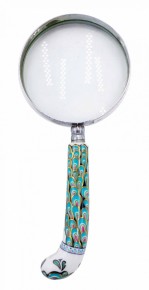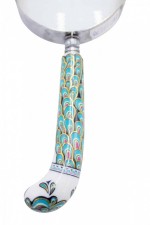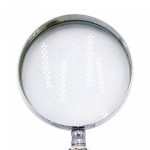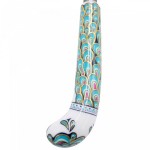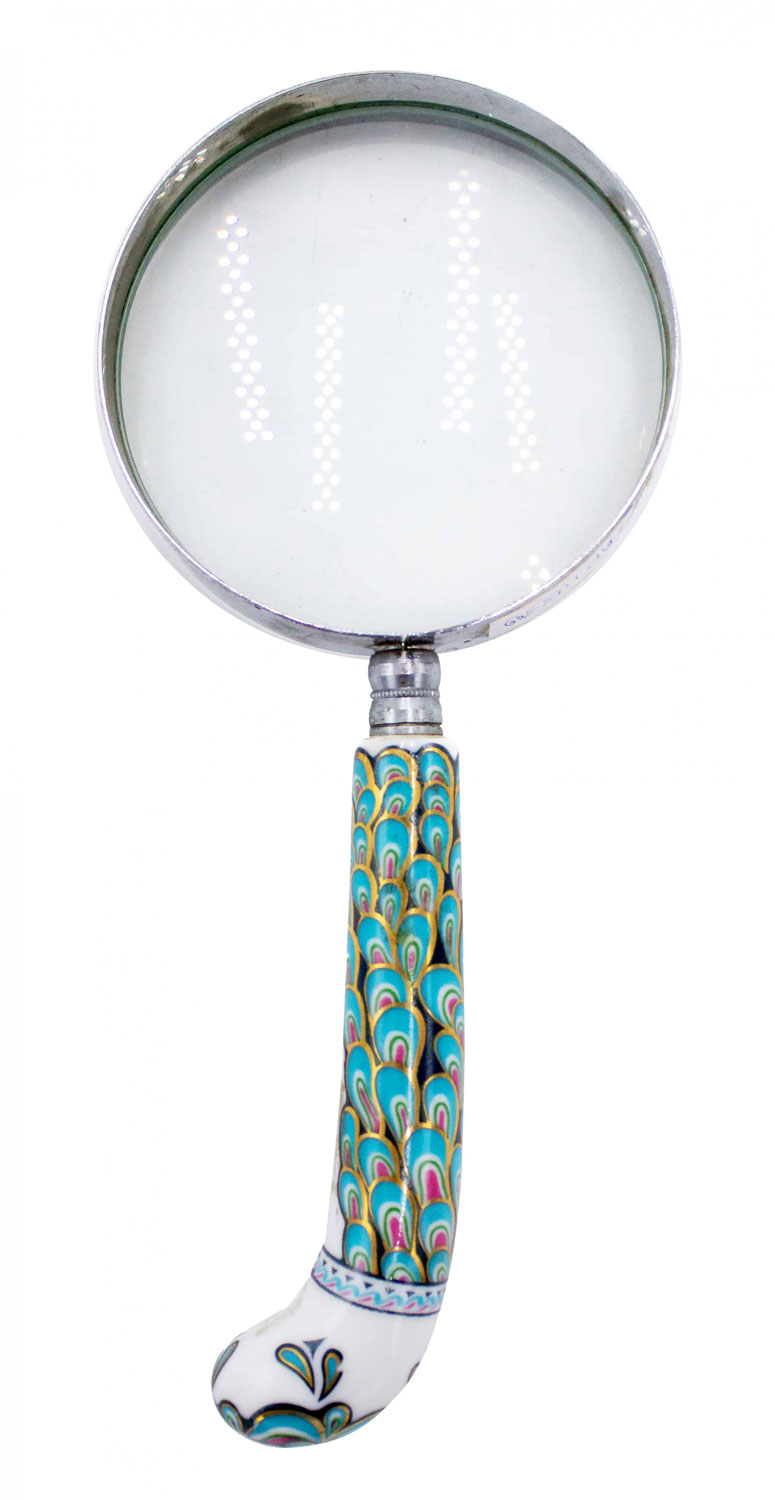French Victorian Cloissone Magnifying Glass
$220 (USD)
Available Qty: 1
Item #: MP1033M
French Victorian-style magnifying glass with a cloisonne porcelain handle..
Ships from:
Newel Gallery
306 East 61st Street, 3rd Floor
NY - 10065
Taxes may apply.
Learn more
See it in Person
Call (212) 758-1970 or Email Us
French Victorian Cloissone Magnifying Glass
Need Assistance?
Call us at 212-758-1970 for assistance With made to order items
Special Order Terms & Conditions
50% due on approval. 50% upon completion Of production. Please refer to Newel's company policies
INQUIRE
PLEASE FILL IN THE REQUIRED FIELDS.
X
French Victorian Cloissone Magnifying Glass
French Victorian-style magnifying glass with a cloisonne porcelain handle.
DETAILS
Sku:
MP1033M
Ships From:
New York, NY
DIMENSIONS (INCHES)
Width:
3.0"
Height:
7.3"
Depth :
3.0"
Diameter :
3.0"
INFO
Style:
Mid-Century
Materials & Techniques:
Glass, porcelain
Category:
Office/Library
related items
2 American Mid-Century Similar Sized Crystal Spinning Top Paper weight
$35
(USD)
QTY: 2
#NWL7154
Width: 2.75"
Depth: 2.75"
Height: 3"
Save to project
American Glass Paper Weight with Mountain Scene
$125
(USD)
QTY: 1
#NWL7102
Width: 3.5"
Depth: 2.25"
Height: 2.5"
Save to project
American Mid-Century Steer Horn Bookends
$540
(USD)
QTY: 1
#DUA0036
Width: 4.75"
Depth: 4.75"
Height: 19.5"
Save to project
Don Shoemaker Mid-Century 3 Piece Jacaranda Desk Set
$1,260
/ Set (USD)
QTY: 1
#REG4110
Width: 15"
Depth: 9"
Height: 1.25"
Save to project
Gucci Mid-Century Modern Dark Brown Leather and Brass Desk Planner
$1,400
(USD)
QTY: 1
#063321
Width: 11"
Depth: 6.5"
Height: 1.5"
Save to project
American Glass Paper Weight with Mountain Scene
$125
(USD)
QTY: 1
#NWL7102
Width: 3.5"
Depth: 2.25"
Height: 2.5"
Save to project
American Mid-Century Steer Horn Bookends
$540
(USD)
QTY: 1
#DUA0036
Width: 4.75"
Depth: 4.75"
Height: 19.5"
Save to project
American Glass Paper Weight with Mountain Scene
$125
(USD)
QTY: 1
#NWL7102
Width: 3.5"
Depth: 2.25"
Height: 2.5"
Save to project
American Mid-Century Steer Horn Bookends
$540
(USD)
QTY: 1
#DUA0036
Width: 4.75"
Depth: 4.75"
Height: 19.5"
Save to project
Don Shoemaker Mid-Century 3 Piece Jacaranda Desk Set
$1,260
/ Set (USD)
QTY: 1
#REG4110
Width: 15"
Depth: 9"
Height: 1.25"
Save to project
Gucci Mid-Century Modern Dark Brown Leather and Brass Desk Planner
$1,400
(USD)
QTY: 1
#063321
Width: 11"
Depth: 6.5"
Height: 1.5"
Save to project
2 American Mid-Century Similar Sized Crystal Spinning Top Paper weight
$35
(USD)
QTY: 2
#NWL7154
Width: 2.75"
Depth: 2.75"
Height: 3"
Save to project
American Glass Paper Weight with Mountain Scene
$125
(USD)
QTY: 1
#NWL7102
Width: 3.5"
Depth: 2.25"
Height: 2.5"
Save to project
American Mid-Century Steer Horn Bookends
$540
(USD)
QTY: 1
#DUA0036
Width: 4.75"
Depth: 4.75"
Height: 19.5"
Save to project
American Mid-Century Steer Horn Bookends
$540
(USD)
QTY: 1
#DUA0036
Width: 4.75"
Depth: 4.75"
Height: 19.5"
Save to project
Don Shoemaker Mid-Century 3 Piece Jacaranda Desk Set
$1,260
/ Set (USD)
QTY: 1
#REG4110
Width: 15"
Depth: 9"
Height: 1.25"
Save to project
Gucci Mid-Century Modern Dark Brown Leather and Brass Desk Planner
$1,400
(USD)
QTY: 1
#063321
Width: 11"
Depth: 6.5"
Height: 1.5"
Save to project
2 American Mid-Century Similar Sized Crystal Spinning Top Paper weight
$35
(USD)
QTY: 2
#NWL7154
Width: 2.75"
Depth: 2.75"
Height: 3"
Save to project
American Glass Paper Weight with Mountain Scene
$125
(USD)
QTY: 1
#NWL7102
Width: 3.5"
Depth: 2.25"
Height: 2.5"
Save to project
American Mid-Century Steer Horn Bookends
$540
(USD)
QTY: 1
#DUA0036
Width: 4.75"
Depth: 4.75"
Height: 19.5"
Save to project
Don Shoemaker Mid-Century 3 Piece Jacaranda Desk Set
$1,260
/ Set (USD)
QTY: 1
#REG4110
Width: 15"
Depth: 9"
Height: 1.25"
Save to project
Don Shoemaker Mid-Century 3 Piece Jacaranda Desk Set
$1,260
/ Set (USD)
QTY: 1
#REG4110
Width: 15"
Depth: 9"
Height: 1.25"
Save to project
Gucci Mid-Century Modern Dark Brown Leather and Brass Desk Planner
$1,400
(USD)
QTY: 1
#063321
Width: 11"
Depth: 6.5"
Height: 1.5"
Save to project
2 American Mid-Century Similar Sized Crystal Spinning Top Paper weight
$35
(USD)
QTY: 2
#NWL7154
Width: 2.75"
Depth: 2.75"
Height: 3"
Save to project
American Glass Paper Weight with Mountain Scene
$125
(USD)
QTY: 1
#NWL7102
Width: 3.5"
Depth: 2.25"
Height: 2.5"
Save to project
American Mid-Century Steer Horn Bookends
$540
(USD)
QTY: 1
#DUA0036
Width: 4.75"
Depth: 4.75"
Height: 19.5"
Save to project
Don Shoemaker Mid-Century 3 Piece Jacaranda Desk Set
$1,260
/ Set (USD)
QTY: 1
#REG4110
Width: 15"
Depth: 9"
Height: 1.25"
Save to project
Gucci Mid-Century Modern Dark Brown Leather and Brass Desk Planner
$1,400
(USD)
QTY: 1
#063321
Width: 11"
Depth: 6.5"
Height: 1.5"
Save to project
Gucci Mid-Century Modern Dark Brown Leather and Brass Desk Planner
$1,400
(USD)
QTY: 1
#063321
Width: 11"
Depth: 6.5"
Height: 1.5"
Save to project
2 American Mid-Century Similar Sized Crystal Spinning Top Paper weight
$35
(USD)
QTY: 2
#NWL7154
Width: 2.75"
Depth: 2.75"
Height: 3"
Save to project
American Glass Paper Weight with Mountain Scene
$125
(USD)
QTY: 1
#NWL7102
Width: 3.5"
Depth: 2.25"
Height: 2.5"
Save to project
American Mid-Century Steer Horn Bookends
$540
(USD)
QTY: 1
#DUA0036
Width: 4.75"
Depth: 4.75"
Height: 19.5"
Save to project
Don Shoemaker Mid-Century 3 Piece Jacaranda Desk Set
$1,260
/ Set (USD)
QTY: 1
#REG4110
Width: 15"
Depth: 9"
Height: 1.25"
Save to project
Gucci Mid-Century Modern Dark Brown Leather and Brass Desk Planner
$1,400
(USD)
QTY: 1
#063321
Width: 11"
Depth: 6.5"
Height: 1.5"
Save to project
2 American Mid-Century Similar Sized Crystal Spinning Top Paper weight
$35
(USD)
QTY: 2
#NWL7154
Width: 2.75"
Depth: 2.75"
Height: 3"

